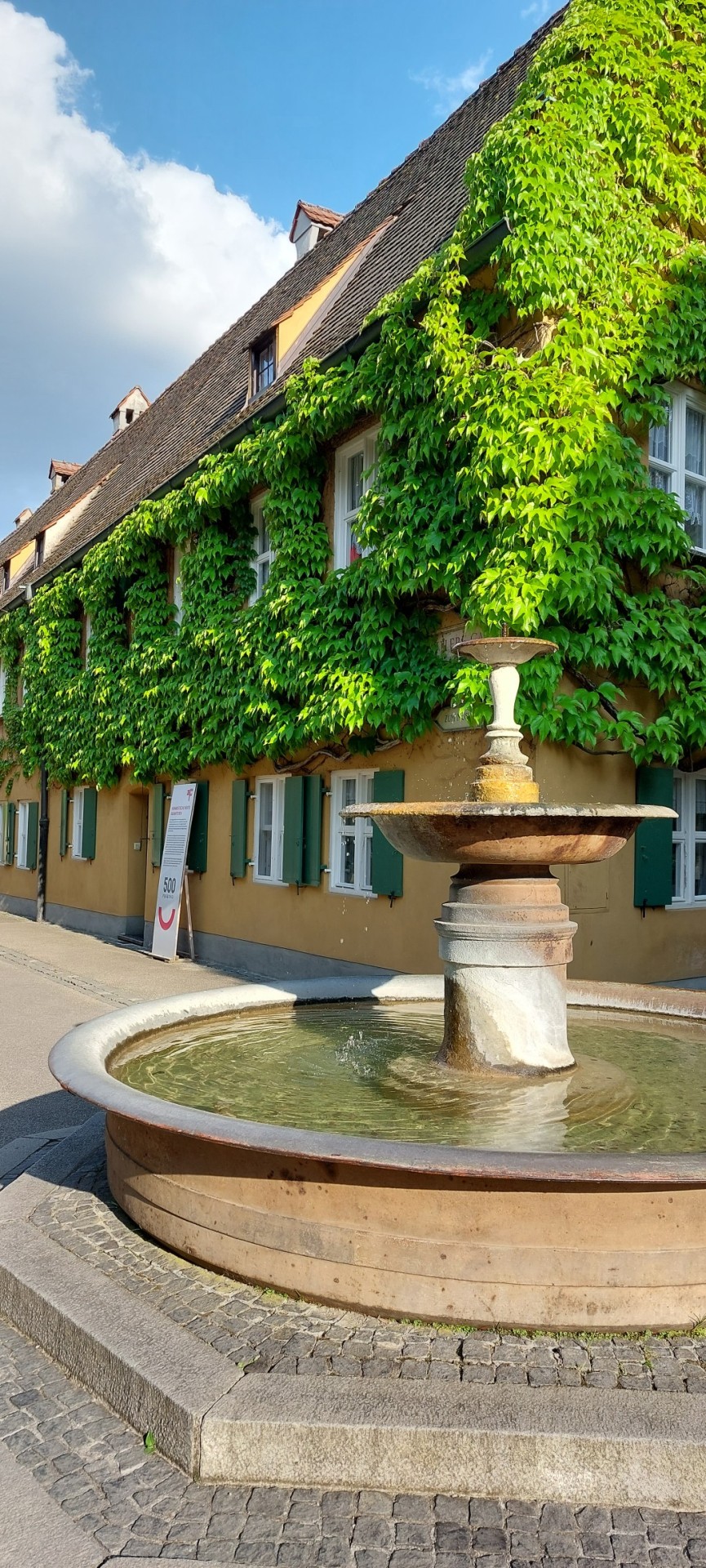#Fuggerei
Explore tagged Tumblr posts
Text
instagram
The Fuggerei, Augsburg, Bavaria, Germany
Approximately 150 needy Augsburg citizens of the Catholic faith live here for an annual base rent of €0.88 and three daily prayers. The Fuggerei with its museum, display residence and World War Bunker can be visited on any day by paying an entrance fee.
Some Glimpses from Germany for your Weekend :)
2 notes
·
View notes
Text
It seems like reels about the fuggerei are getting popular lately because of the ridiculously low rent (0.88€ a year) and bizarre conditions residents have to meet, i need people to understand how hilarious the reason was why this place was built.
500 years ago, the founder at one point looked back at his life, and being a devoted catholic he realised he's not gonna see the pearly gates. so he created a secluded living complex with super cheap rent and the condition that residents have to pray for his soul 3 times a day. He created a Catholic prayer farm. A PRAYER FARM
4 notes
·
View notes
Text
Augsburg: La Città della Storia e dell'Innovazione tra Tradizione e Futuro. Scopri la città bavarese di Augsburg, un gioiello di storia e cultura che si fonde con il dinamismo moderno, rendendola una destinazione imperdibile in Germania
Augsburg, situata nel cuore della Baviera, è una delle città più antiche della Germania, fondata dai Romani nel 15 a.C. Questa affascinante città ha visto prosperare diverse epoche storiche e oggi rappresenta un perfetto equilibrio tra tradizione e innova
Augsburg, situata nel cuore della Baviera, è una delle città più antiche della Germania, fondata dai Romani nel 15 a.C. Questa affascinante città ha visto prosperare diverse epoche storiche e oggi rappresenta un perfetto equilibrio tra tradizione e innovazione. Dalla sua straordinaria architettura rinascimentale al fervente sviluppo tecnologico, Augsburg è un centro culturale e industriale che…
#Architettura Medievale#Arte Rinascimentale#attrazioni in Baviera#Augsburg#Augsburger Plärrer#Baviera#Cattedrale di Augsburg#Cattedrale gotica#città della Svevia#città industriale#città medievale#città storica#complesso abitativo storico#eventi culturali Augsburg#eventi in Augsburg#Festival delle Luci#Fugger#Fuggerei#Goldener Saal#Innovazione tecnologica#Mobilità sostenibile#modello di sostenibilità#Monumenti Storici#Mozart Festival#rinascimento tedesco#storia di Augsburg#Sviluppo Urbano Sostenibile#tradizione bavarese#Turismo Culturale#turismo eco-friendly.
0 notes
Text
pettifoggery excellent word of the english language you guys should use it more
#the fact that it may come from Fugger (family) is so next level international historical haterism#big fan of the fuggerei though
35 notes
·
View notes
Text

Erika Groth-Schmachtenberger. Fuggerei, Augsburg. Entrance of the Jakoberstraße, 1934
#erika groth-schmachtenberger#vintage#photography#black and white#art#history#street photography#black and white photography#vintage photography#germany#1930s
158 notes
·
View notes
Note
C might mean well, but I find businesses using charity to sell suspicious.
Dear Provocative Anon,
What you say deserves an audio (there have been two of them two weeks ago, compensating for last week's silence). I have many things to tell you and please excuse the delay:
They really can't win, with people like you, can they? And that goes for both C and S, mind you. No matter what they do and try to promote as a side project, there is always going to be someone unhappy and vocal about it. When it's not you complaining 'business using charity to sell' is 'suspicious', there's the other fuckwit asking recently why S hasn't given all MPC's profit to charity, as Paul Newman did with Newman's Own.
So, I will be brutally honest with you, Anon. I have thoughts and questions about your own point of view and this is partially why it took me so long to answer you. It would seem you are not familiar at all with what is called 'corporate social responsibility' (CSR), since at least the Sixties. Which means, in a nutshell, companies who choose to focus part of their activity and dedicate part of their profits to charitable projects. It is done with various degrees of ethics, success and bona fides all around the world, and it is often used as a strong marketing and sales argument.
Think about these people, whose brand is probably immediately recognizable wherever you go, spare perhaps Pyongyang:

I just picked this Coca Cola Foundation recent CSR project in Brazil totally randomly, using Google. Some might think it's just another cynical diversion: one of the world's biggest corporate profiteers, happily contributing to the current obesity pandemic (including in Latin America), suddenly showing one of its biggest markets they do have a conscience, after all, and a social one to boot. And addressing, at the same time, one of the continent's post-colonial bleeding wounds, which is to say, the organic imbalance between rich and poor, as far as access to means of production, land ownership and use and sales opportunities go. 480 farmers benefitting from Coca Cola's magnanimity is probably but a tiny drop of hope in an ocean of dour social injustice, but the truth is, Anon, if nobody does anything good, then nothing good will happen at all. It is as simple as that, and while their modus operandi is probably not exactly my cup of tea, you will have to admit it works, at least to some extent and for some people. Plus it greatly enhances the company's do-good, sensible and reliable global image, because of course, what happens right now in the state of Minas Gerais is but a tiny part of a bigger strategy.
Might I add that even those robber barons, à la Cornelius Vanderbilt or Jay Gould, who made their ruthless fortunes building the railroads of a still very young United States of America, ended up giving a very small part of their same fortune to various charities. It wasn't nearly enough what we would consider as 'reasonable', in 2024, but it did start a philanthropic trend, that took considerable speed after the 1919 Boston Molasses Disaster. The Sixties have just added more pragmatism and gave a name to what was, at its very start, quite an opportunistic endeavor.
Even so, Vanderbilt and Gould themselves did not invent anything, really. One should look to good old Europe to find what is probably the first big CSR project in human history, still going strong since 1521. May I introduce you to the Augsburg Fuggerei:


[for even more pious charity: https://www.fugger.de/en/fuggerei]
Renting one of those wonderful Hansel and Gretel houses for less than one euro/year, plus three daily Hail Mary is something to behold, right? Jakob Fugger the Young, the guy who had this brilliant idea (which, might I add, is still run and operated by the Fugger banker family, even nowadays) was literally a ruthless kingmaker, a colonial trade and exploration pioneer, but also a religious bigot who flatly refused to extend his charity to Protestant families. Still, his pious dream goes on - the Fugger Family Foundation even actively plans its next 500 years. This is Germany, after all 😉.
Those people’s money stinks more of corruption and crime than S or C’s ever could, Anon. Still, they are remembered as benefactors, by many. History is seldom cruel to those who are willing to pay for their posterity.
But you know what, Anon? Compared to the Fuggers and the Vanderbilts and the Goulds, S and C are really small fish in an even smaller, fickler pond. I think they are doing it out of their good heart and I think they are honestly, genuinely responsive to the idea of giving a chance to young, struggling artists. But, in the process, are they also trying to market themselves as more approachable and less controversial, considering the (oh, I shall never tire to repeat this, with gusto) cosmic amount of bullshit plaguing their respective public images? My somewhat cynical answer is also yes, Anon. To which may I immediately add that it's not even important: all that counts are the tangible results of whatever good things they do with their booze and/or fitness profits.
Results and helping trigger a change in one's life is all that really interests me, Anon. It seems to bother you, though, so I will cheekily end this long rant with a couple of questions: do you have a problem with poverty? do you believe in giving people a (second) chance, or do you think only the rich are worth considering and valuable?
If so, I honestly pity you, girl. For the real indigent in all this might be you.
67 notes
·
View notes
Note
So, in a very brief aside when you mentioned the spoke-and-wheel model for King's Landing. You also mentioned public housing in flea bottom, sewer and water systems, and public hospitals. I'm a little curious, what would that look like in a medieval setting? How would a system with a less developed administrative system handle public housing?
Administratively, it would be a lot simpler than our modern public/social housing system. It would probably look more like charity housing than a state system that provides comprehensive services above and beyond a roof over one's head, but it could be done in the period.

This is the Fuggerei, the world's oldest continually-operating public housing that dates back to 1514. A 52-unit walled complex, these apartment buildings were a charitable donation by the famous Fugger banking family (it's good to be the personal bankers to the Hapsburgs when the Holy Roman Emperor doesn't quite understand international arbitrage in silver prices) to the poor people of Augsberg, Bavaria.
Eligibility criteria hasn't changed: in order to be eligible, residents must be living in poverty but not have debts, they must have lived in Augsburg for two years, and they must be Catholics. Likewise, rents haven't changed much: residents of the Fuggerei pay one Rhenish gulden (roughly 1 euro) a year, must say the Lord's Prayer, a Hail Mary, and the Nicene Creed once per day for the souls of the Fugger family, and must work at least part time.
So that's what public housing in Flea Bottom might look like.
#asoiaf#asoiaf meta#king's landing#public housing#hapsburgs#early modern history#renaissance history
64 notes
·
View notes
Text

Photo by Erika Groth-Schmachtenberger. Fuggerei, Augsburg. Entrance of the Jakoberstraße, 1934
#Vintage Photo#old photo#sealed in time#historical photo#history photo#photos#history#photography#black and white photography#vintage photography#black and white#black and white photo#history lovers#history in pictures#antique photo#timeless photo
9 notes
·
View notes
Text
Bavaria being Rhodolite
Let s start with the munich residence shall we?
I just HAVE to share Queen Theresa's library in Munich cause 🥰 Chevalier vibes 🥰

I swear this is the throne room:

It just needs a long carpet.
Then we have the green galery:

Idk which part this would be but it's freaking beautiful
Some very nice stairs that would totally fit to our favourite palace:

I'm afraid this is the closest that i found to a ball room:

If you don't like this here's Nymphemburg and one from Augsburg with more rhodolitian vibes:


Can't have a palace without a royal carriage:

And this is the Fuggerei, homes for the homeless in Augsburg, but tell me it's not the town

Last but not least;
The royal chapel:

That is all
Thank you for your attention!
#rhodolite#ikemen series#ikemen prince#ikepri#chevalier michel#ikepri clavis#ikepri chevalier#clavis lelouch#cybird
56 notes
·
View notes
Text

The Fuggerei in Augsburg, Germany, is the world's oldest social housing complex still in use.
Founder, German businessman Jakob Fugger wanted to create affordable housing for the poor.
Built on a 500-year-old agreement, approximately 150 needy Augsburg citizens of the Catholic faith live here for an annual base rent of €0.88 along with three daily prayers ��� the Lord's Prayer, Hail Mary, and the Nicene Creed – and doing a part-time job in the community such as being a gardener or a night watchman.
By 1523, 52 houses had been built, and in the coming years the area expanded with various streets, small squares and a church.
Expanding further in 1880 and 1938, the Fuggerei today comprises 67 houses with 147 apartments, a well and an administrative building.
Each unit has its own street entrance, it simulates living in a house. Ground-floor apartments all have a small garden and garden shed, while upper-floor apartments have an attic. All apartments have modern conveniences and a spare room.
The doorbells have elaborate shapes, each being unique, dating back to before the installation of streetlights when residents could identify their door by feeling the handle in the dark.
Standard rent in Germany is approximately €940 for a 1-bedroom, city-centre apartment. €700 for a 1-bedroom apartment outside of the city centre. €450 for a room in a shared flat.
It's estimated there are about 80 people on the waiting list for the Fuggerei.
5 notes
·
View notes
Text
ja, gibt es ... https://www.fugger.de/fuggerei : "
Die Fuggerei ist die älteste bestehende Sozialsiedlung der Welt, eine Stadt in der Stadt mit 67 H��usern und 142 Wohnungen sowie einer eigenen Kirche. Jakob Fugger stiftete die Fuggerei auch im Namen seiner Brüder im Jahr 1521. Es leben hier rund 150 bedürftige Augsburger Bürger katholischen Glaubens für eine Jahreskaltmiete von 0,88 € und täglich drei Gebeten. Die vier Museen in der Fuggerei mit einer rekonstruierten historischen Wohnung und der Ausstellung im Weltkriegsbunker können täglich gegen Eintritt besichtigt werden.
yes, there is … https:\/\/www.fugger.de\/fuggerei : ' The Fuggerei is the oldest existing social housing estate in the world, a city within a city with 67 houses, 142 apartments and its own church. Jakob Fugger founded the Fuggerei in 1521 on behalf of his brothers. 150 needy Augsburg citizens of Catholic faith live here for an annual rent of €0.88 and three prayers a day. The four museums in the Fuggerei, including a reconstructed historic apartment and the exhibition in the Second World War bunker, are open daily for an entrance fee.

1K notes
·
View notes
Text

Rent is Still $1 a Year at the World’s Oldest and Most Beautiful Social Housing Project fuggerei-1 https://www.messynessychic.com/2021/02/23/rent-is-still-1-a-year-at-the-worlds-oldest-and-most-beautiful-social-housing-project/ … http://www.andrejweingerl.com/aawk.html#tretji
architecture #interior
0 notes
Text
Fuggerei: the world’s first public housing (2022)
https://www.karlsnotes.com/fuggerei-the-worlds-first-public-housing/
0 notes
Text

En el pueblo alemán de "Fuggerei" el alquiler no aumenta desde 1520 y vivir allí durante todo un año cuesta solo 1 euro.
Esto se debe a que las tierras y las casas del pueblo pertenecen a una familia, que decidió preservar esta antigua tradición y de cierta forma atraer nuevos residentes.🏡

0 notes
Text
PENSION ALIS Unterkunft in Augsburg
4 km von Augsburgs Stadzentrum entfernt, verfügt das Pension Alis über kostenloses Wi-Fi im ganzen Gebäude. Fugger Museum und Fuggerei ist innerhalb von 10 Minuten mit dem Auto erreichbar. In einer 3,7 km Entfernung befindet sich Kirche St. Ulrich und St. Afra. Die Gäste können im Nongs Thai-Imbiss in 150 Metern von der Unterkunft essen. Die Bushaltestelle Eppaner Strasse befindet sich ganz nebenan. Der Flughafen Augsburg liegt etwa 11 Autominuten entfernt. Die Freizeitangebote beinhalten eine Bar und einen Patio. Read the full article
0 notes